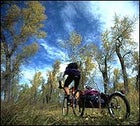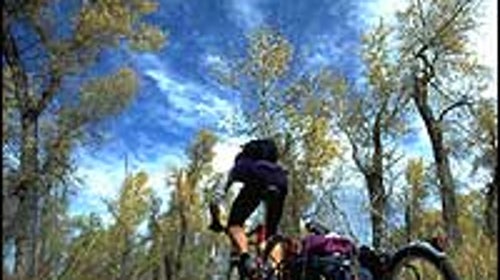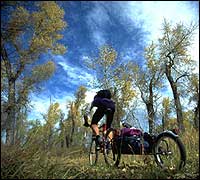Every autumn for the last six years, James Harvey has left his home in Telluride, Colorado, for a self-supported bicycle trek through some exotic land. In his thousands of miles of touring, Harvey, 35, has been shaken down by the federales of three nations (Brazil, Guatemala, and Italy), has held his tongue as hoodlums threatened his life, and has watched in horror as his partner’s front rack broke, swinging a pannier through the front wheel and catapulting the guy into a series of 30-mile-an-hour somersaults.

Still, Harvey relishes these trips, largely because they provide sweet relief from his summer duties, guiding mountain bike tourists through the Rockies for his company, Backcountry Biking (970-728-0861). The difference, of course, is self-sufficiency—the key to a successful dream ride. “Carry what you need,” he says, “and you’ll have the freedom to go anywhere.” This is just one bit of advice that he would pass along to you. The rest of it follows.
Planning: Once you’ve chosen a destination, Harvey says, make sure your visit won’t coincide with the area’s monsoon or hurricane season, national elections, or any other potential disasters. Learn the direction of the prevailing winds, so as to have them at your rear. Whether you’re touring on- or off-road, pick different arrival and departure points to avoid backtracking, since fresh scenery is bike touring’s primary appeal.
On the dirt, plan on covering no more than 45 miles a day on fire roads, or more like 30 if you have to tackle a long stretch of singletrack or a high pass. For a trip of five days of less, you can easily carry all the food you’ll need; if, however, you’re embarking on an epic, make sure you can get to a town with services (and that the services are available on, say, Sundays) about every 150 miles. Also, bring the number of a mail-order gear company; if you break a part and there’s no shop in the vicinity, you can have a replacement shipped to the nearest post office for general delivery. On the road, Harvey likes to log about 350 miles a week, making sure to vary the mileage day to day so he doesn’t start to feel like a rat on a treadmill. “You’ll want to push it on some days and kick back on others,” he says.
Packing: To keep the weight of his load down, Harvey brings as little as possible in the way of clothing and toiletries. but when it comes to gear, he trades minimalism for preparedness. The broken rack incident illustrates why. “That could have snowballed into disaster,” he says. “But we had a first-aid kit to clean his wounds. We had a spoke wrench to fix his wheel. We had a tent a sleeping bags, so we didn’t need to limp a distant hotel in the dark. A tent—even if you use it only half the time—will save your ass.” In addition to these and other obvious needs (sandals for beaches and scummy campground showers, at least two pairs of padded bike shorts), Harvey also recommends bringing the items on the following list, which he has graciously annotated.
A toolkit, including two tire levers, two pumps, a patch kit, Allen wrenches ranging from three to six millimeters, a chain tool, lube, five spare tubes, and duct tape: “Never underestimate how much a flat tire can hurt you.”
A water filter and backup iodine: “And bring something like Tang to kill the taste of bad water.”
Light hiking shoes for use both on and off the bike (you’ll need conventional pedals): “Shoes for clipless pedals don’t work so well for walking, and you don’t want to lug around an extra pair.”
A light kitchen, including a small camp stove, one pot, durable plastic utensils, and several plastic containers: “Tupperware lets you store breakfast leftovers and eat them for dinner.”
A compass and up-to-date maps, which means USGS topos when you’re off-road in America or the equivalent overseas: “A wrong turn in a car is an annoyance. On a bike it can ruin your whole day.”
Lightweight cotton pants: “Not just for more formal situations, but for mosquitoes. Jeans are way too heavy.”
And rain pants, as well as the usual jacket: “They’re light and can save your knees from freezing.”
To carry all your stuff you’ll have to make a choice between panniers and a trailer. The former make for simple portaging and allow you to segment gear easily, but their wide profile is a drag—literally—in strong headwinds and on overgrown singletrack. Trailers, meanwhile, work quite well in the woods, requiring no more width than your shoulders and, because they hinge independently from the rear wheel, bouncing over obstacles without throwing you off balance. They also provide abundant storage and quickly unhitch so you can unweight your bike for side jaunts. The drawback? In a crosswind you’ll swear you’re pedaling a semi, and worse, friends with panniers will inevitable load you up with extra stuff. As for your biggest piece of gear, a touring bike is fine if you plan to stick exclusively to pavement and thus pass up good camping spots that are even a mile off the beaten track. Otherwise you’ll want a hard-tail mountain bike, which is supremely durable and versatile, especially if you outfit it with semislick tires 1.9-inches or wider (to support the extra weight). You’ll be able to handle dirt roads and trails and still whiz right along on the pavement, scoffing at potholes.
Riding: Before you jet off on a tour, test-ride your rig in all its loaded glory. “Bang it into curbs, throw it over obstacles, and make sure you can portage it,” Harvey advises. On a loaded bike, you want to downshift enough so you can still spin at a high rpm. Things don’t get terrible tricky, though, until you need to slow down. Brake early and gradually going into turns and maintain an upright position; if you don’t your trailer might whip around you like a tetherball. And on long, steep descents, feather your brakes, both to keep your speed in check and to keep the brake pads in working order. Clamping down on them can cause the pads to disintegrate, in which case stopping will require using your body as an anchor.
Wherever you may be, ride like you belong there. Take your portion of the road—the tree feet inside the shoulder—to ensure that motorists see you. On the dirt, look back and check your gear frequently; washboard fire rods can rattle paniers off, and trees and scrub brushes alongside singletrack can snatch away brand new rain jackets. And whatever your intended destination each day, be flexible. Do you really want to pass up a prime campsite and push on into terra incogniata? No, says Harvey: “On a bike tour, spontaneity can be just as important as planning.”


